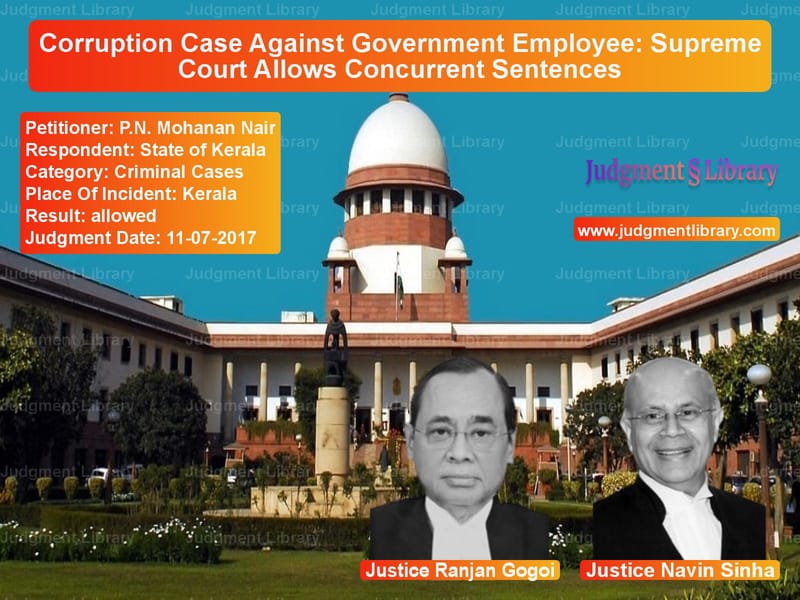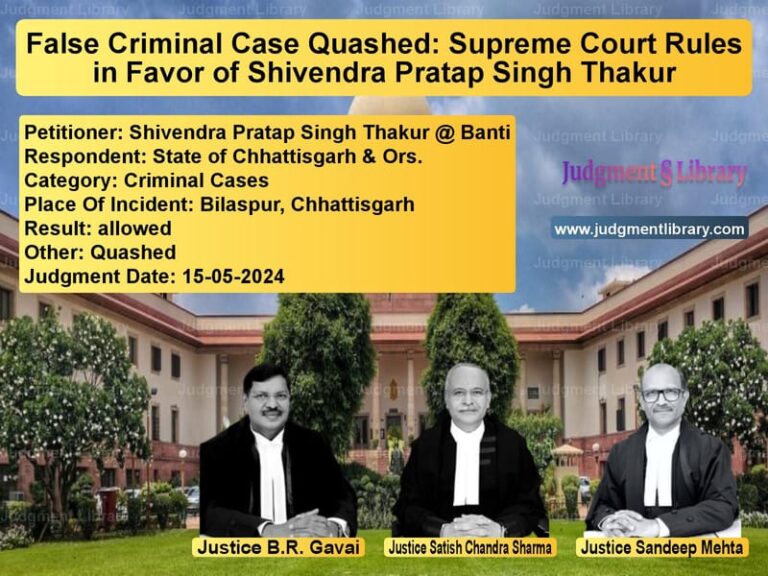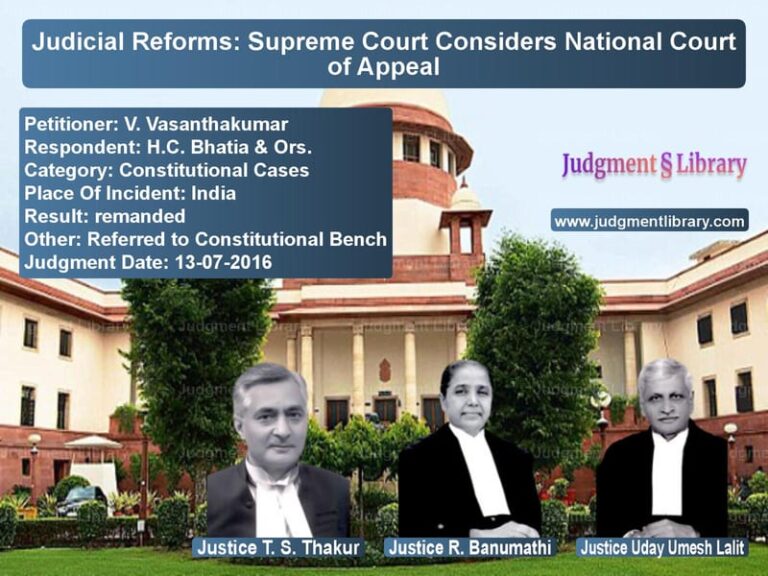Corruption Case Against Government Employee: Supreme Court Allows Concurrent Sentences
The Supreme Court’s judgment in P.N. Mohanan Nair vs. State of Kerala, delivered on July 11, 2017, addressed the legal question of whether multiple sentences imposed in different criminal cases should run concurrently or consecutively. The ruling clarified the interpretation of Section 427(1) of the Code of Criminal Procedure (CrPC) and reinforced the judicial discretion in determining concurrent sentences.
The case involved a government employee, P.N. Mohanan Nair, a Peon in the office of the Sub-Registrar, Vazhoor, who was convicted for misappropriating government funds over multiple periods. He was found guilty under the Prevention of Corruption Act, 1988, and Sections 409, 465, and 471 of the Indian Penal Code (IPC). The Supreme Court held that since the offenses arose from a single transaction split into multiple cases, the sentences should run concurrently rather than consecutively.
Background of the Case
The accused, P.N. Mohanan Nair, was alleged to have embezzled government funds totaling Rs. 92,225 from 1995 to 1996. He created false challans to show remittance of funds into the treasury while misappropriating the money.
Key events in the case:
- 1995-1996: Misappropriation of public funds occurred in multiple transactions.
- 2002: Three separate criminal cases were registered against the accused.
- 2005: The Special Judge convicted him, sentencing him to one year rigorous imprisonment in each case.
- 2015: The Kerala High Court upheld the conviction.
- 2016: The Supreme Court granted leave to appeal and reconsider the running of sentences.
- July 11, 2017: The Supreme Court ruled that the sentences should run concurrently.
Arguments by the Petitioner (P.N. Mohanan Nair)
The petitioner’s counsel argued:
- All three cases arose from a single transaction split into different periods.
- The prosecution registered three separate cases only for procedural convenience.
- Common evidence was recorded for all cases.
- Under Section 427(1) of CrPC, when a person is convicted in multiple cases arising from the same transaction, the sentences should run concurrently.
- Since the accused was 68 years old, serving consecutive sentences would be unduly harsh.
Arguments by the Respondent (State of Kerala)
The prosecution countered with the following arguments:
- Each case represented a distinct offense occurring during different time frames.
- The misappropriated amounts in each case were separate, and sentencing in each case should be served individually.
- The law permits courts to decide whether sentences should be consecutive or concurrent based on the nature of the offense.
- Since corruption undermines public trust, strict punishment should be imposed.
Supreme Court’s Observations
The Supreme Court, comprising Justices Ranjan Gogoi and Navin Sinha, made the following key observations:
“The allegations constituted a single transaction, between the same parties, for a block period, split up by the prosecution, presumably for its convenience, into three different cases.”
“Section 427(1) of CrPC stipulates that where a person undergoing a sentence of imprisonment is sentenced on a subsequent conviction, it shall commence at the expiration of the previous imprisonment unless the court directs otherwise.”
“The jurisdiction being discretionary must be exercised on fair and just principles in the facts of a case.”
Supreme Court’s Judgment
The Supreme Court ruled:
- The offenses essentially constituted a single transaction, justifying concurrent sentences.
- The sentences in all three cases should run concurrently.
- The default sentence for failure to pay fines would run separately.
- The appellant was entitled to immediate release if his sentence duration was already completed.
Key Takeaways
- Interpretation of Section 427(1) CrPC: Courts have discretion to determine whether multiple sentences should run concurrently or consecutively.
- Single Transaction Rule: When multiple offenses arise from a single fraudulent act, sentencing should not be overly punitive.
- Judicial Discretion: The ruling emphasizes fairness in sentencing rather than mechanically applying consecutive sentences.
- Relief for Aged Accused: The Supreme Court acknowledged the advanced age of the accused as a factor in sentencing.
Impact of the Judgment
The ruling has significant implications for criminal law:
- Ensures proportionality in sentencing, preventing excessive punishment in multi-case prosecutions.
- Clarifies that procedural convenience in filing multiple cases should not lead to unfair sentencing.
- Sets a precedent for similar corruption and fraud cases.
- Provides relief to older convicts facing long-term imprisonment due to technical case-splitting.
Conclusion
The Supreme Court’s decision in P.N. Mohanan Nair vs. State of Kerala reinforces judicial discretion in sentencing and ensures fairness in cases involving multiple prosecutions for a single transaction. By allowing concurrent sentences, the ruling prevents unduly harsh punishment while upholding the principles of justice and proportionality.
Don’t miss out on the full details! Download the complete judgment in PDF format below and gain valuable insights instantly!
Download Judgment: P.N. Mohanan Nair vs State of Kerala Supreme Court of India Judgment Dated 11-07-2017.pdf
Direct Downlaod Judgment: Direct downlaod this Judgment
See all petitions in Fraud and Forgery
See all petitions in Money Laundering Cases
See all petitions in Bail and Anticipatory Bail
See all petitions in Judgment by Ranjan Gogoi
See all petitions in Judgment by Navin Sinha
See all petitions in allowed
See all petitions in supreme court of India judgments July 2017
See all petitions in 2017 judgments
See all posts in Criminal Cases Category
See all allowed petitions in Criminal Cases Category
See all Dismissed petitions in Criminal Cases Category
See all partially allowed petitions in Criminal Cases Category







